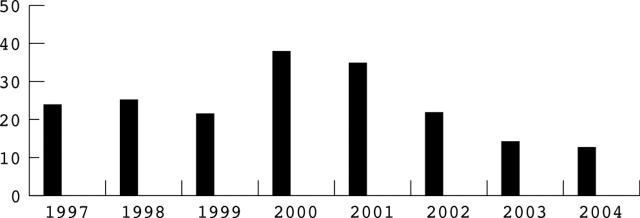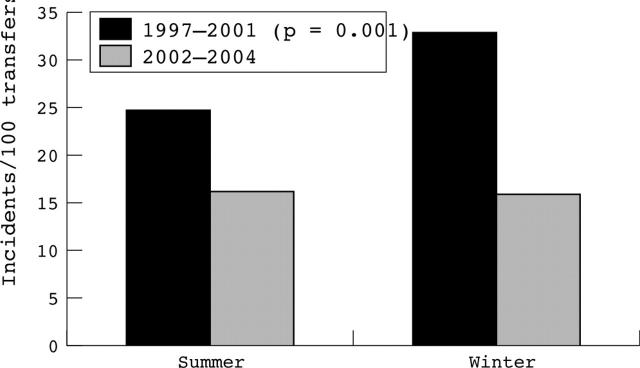Abstract
Background: Critical incidents are common during the inter-hospital transfer of sick patients, and infants are an especially vulnerable group.
Aims: To examine the effect of critical incident review on the number of adverse events during inter-hospital transfer of sick infants.
Methods: Critical incidents over an eight year period are reported from a single neonatal transfer service before and after major service changes were made. The changes were instigated as part of ongoing critical incident reviews.
Results: Changes made as a result of critical incident review significantly reduced the number of incidents contributed to by poor preparation, transport equipment or clinical problems, ambulance delays, and ambulance equipment failure.
Conclusions: The continuous process of critical incident reporting and review can reduce the number of adverse events during the transfer of critically ill infants.
Full Text
The Full Text of this article is available as a PDF (65.6 KB).
Figure 1.
Number of transfers with critical incidents per 100 transfers by year.
Figure 2.
Transfers on which incidents occurred per 100 transfers by season.
Selected References
These references are in PubMed. This may not be the complete list of references from this article.
- Armstrong Schellenberg Joanna R. M., Adam Taghreed, Mshinda Hassan, Masanja Honorati, Kabadi Gregory, Mukasa Oscar, John Theopista, Charles Sosthenes, Nathan Rose, Wilczynska Katarzyna. Effectiveness and cost of facility-based Integrated Management of Childhood Illness (IMCI) in Tanzania. 2004 Oct 30-Nov 5Lancet. 364(9445):1583–1594. doi: 10.1016/S0140-6736(04)17311-X. [DOI] [PubMed] [Google Scholar]
- Barry P. W., Ralston C. Adverse events occurring during interhospital transfer of the critically ill. Arch Dis Child. 1994 Jul;71(1):8–11. doi: 10.1136/adc.71.1.8. [DOI] [PMC free article] [PubMed] [Google Scholar]
- Broughton Simon J., Berry Andrew, Jacobe Stephen, Cheeseman Paul, Tarnow-Mordi William O., Greenough Anne. An illness severity score and neonatal mortality in retrieved neonates. Eur J Pediatr. 2004 Apr 16;163(7):385–389. doi: 10.1007/s00431-004-1451-8. [DOI] [PubMed] [Google Scholar]
- Chance G. W., Matthew J. D., Gash J., Williams G., Cunningham K. Neonatal transport: a controlled study of skilled assistance. Mortality and morbidity of neonates less than 1.5 kg birth weight. J Pediatr. 1978 Oct;93(4):662–666. doi: 10.1016/s0022-3476(78)80913-5. [DOI] [PubMed] [Google Scholar]
- FLANAGAN J. C. The critical incident technique. Psychol Bull. 1954 Jul;51(4):327–358. doi: 10.1037/h0061470. [DOI] [PubMed] [Google Scholar]
- Fenton A. C., Leslie A., Skeoch C. H. Optimising neonatal transfer. Arch Dis Child Fetal Neonatal Ed. 2004 May;89(3):F215–F219. doi: 10.1136/adc.2002.019711. [DOI] [PMC free article] [PubMed] [Google Scholar]
- Holt J., Fagerli I. Air transport of the sick newborn infant: audit from a sparsely populated county in Norway. Acta Paediatr. 1999 Jan;88(1):66–71. doi: 10.1080/08035259950170637. [DOI] [PubMed] [Google Scholar]
- Leslie A. J., Stephenson T. J. Audit of neonatal intensive care transport--closing the loop. Acta Paediatr. 1997 Nov;86(11):1253–1256. doi: 10.1111/j.1651-2227.1997.tb14856.x. [DOI] [PubMed] [Google Scholar]
- Whitfield J. M., Buser M. K. Transport stabilization times for neonatal and pediatric patients prior to interfacility transfer. Pediatr Emerg Care. 1993 Apr;9(2):69–71. doi: 10.1097/00006565-199304000-00002. [DOI] [PubMed] [Google Scholar]




